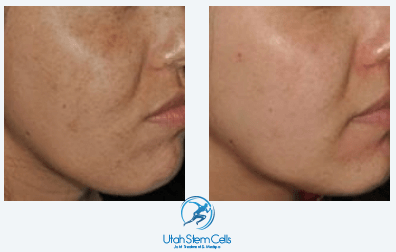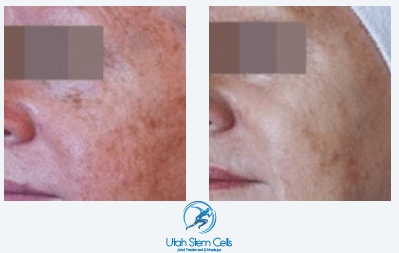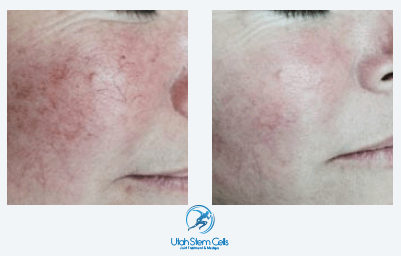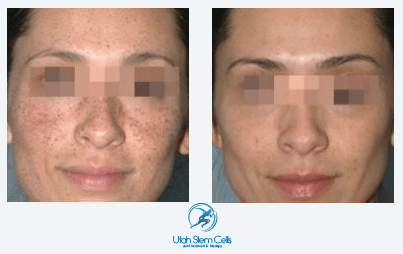INTENSE PULSED LIGHT (IPL) SANDY, UT
Intense Pulsed Light (IPL) Photofacial
Intense pulsed light (IPL) Photofacial is a laser light treatment that targets pigment issues, such as dark or brown spots, age spots, and red spots, to name a few. The bright light passes through the epidermis, drawing out the dark spots and dispersing the uneven red pigment.
For best results, 3-5 treatments are typically recommended, about four weeks apart.
What does IPL Photofacial treat?
- Age Spots
- Freckles
- Sun Damage
- Spider Veins
- Redness
- Rosacea (enlarged facial blood vessels)
- Large Pores
- Pigment Imperfections
FAQ
Photofacial (aka IPL) uses a light-based system to treat vascular lesions, benign pigmented areas, enlarged spots, and surface skin irregularities, such as fine lines and wrinkles.
If you are frustrated by any of the skin problems below, then Photofacial can be a good choice for you:
- Hyperpigmentation (brown spots)
- Sunspots and aging signs
- Rosacea
- Broken capillaries
- Freckles
Most patients see results after the very first treatment. We recommend that you complete a 3-6 sessions protocol for better, long-lasting results.
Area treated will look darker for up to 10 days and it can look a little red for a few days post-treatment for facial redness. There is no actual downtime though. Make-up can be applied immediately and returning to work immediately is also possible. We recommend you use a Medical Grade SPF right after your treatment.

- Extended sun exposure 3-4 weeks prior to treatment, there must be no remaining tan left in the skin
- Discontinue use of self-tanner 2 weeks prior to appointment, there must be no remaining tan left in the skin
- Discontinue use of products containing active ingredients (such as glycolic acid, salicylic acid, benzoyl peroxide, etc.) for 1 week prior to treatment
- Discontinue use of Isotretinoin (Accutane) 1 year prior to treatment
- Discontinue use of prescription-grade Retin-A 60 days prior to treatment
- Discontinue use of over the counter retinol 60 days prior to treatment
- Avoid chemical peels in the treatment area 2 weeks prior to being treated with a laser
- When receiving an IPL treatment do not wax the area 2 weeks prior and 2 weeks post-treatment
- To receive laser hair removal do not wax or tweeze for a minimum of 30 days prior to treatment
- Discontinue use of depilatory creams/sprays area 6 weeks prior to treatment
- For laser hair removal DO shave the area to be treated the day before or the day of your treatment
- Wait for 2 weeks to receive a laser treatment after receiving botox/fillers in the treatment area
- Lasers cannot be used on areas with permanent make-up
- Discontinue use of certain photosensitizing medications, vitamins and herbs including but not limited to topical or oral antibiotics or steroids
- Do not elevate body temperature (hot-tubbing, sauna, intense exercise, etc.) for 2 hours prior to treatment
- When receiving IPL plan to not raise body temperature for 48 hours post-treatment
- When receiving laser hair removal plan to not raise body temperature for 12 hours post-treatment
- Metal implants in the treatment area
- Pacemaker/internal defibrillator
- Surgeries within 6 months that could possibly cause an adverse event related to treatment
- Pregnant or nursing
- Current history of cancer (especially skin cancer)
- Polycystic Ovarian Syndrome
- Impaired immune system/use of certain immuno-suppressive medications
- Any major health disorders such as cardiac disorders, epilepsy, liver or kidney diseases, etc.
- History of heat-related histamine reactions
- History of bleeding and anticoagulants
- Hypertension
- Diabetes or thyroid dysfunction
- Herpes Simplex. Patients may want to begin prophylactic anti-virals 2-3 days prior to treatment
- Open lesions
- Active acne
- Active skin diseases such as psoriasis or vitiligo
- Medical conditions that impair skin healing
- History of keloid or hypertrophic scarring
- Low pain tolerance (use of anti-inflammatories or numbing creams is not recommended while receiving IPL or laser hair removal treatment)
Real Patients. Real Results.










